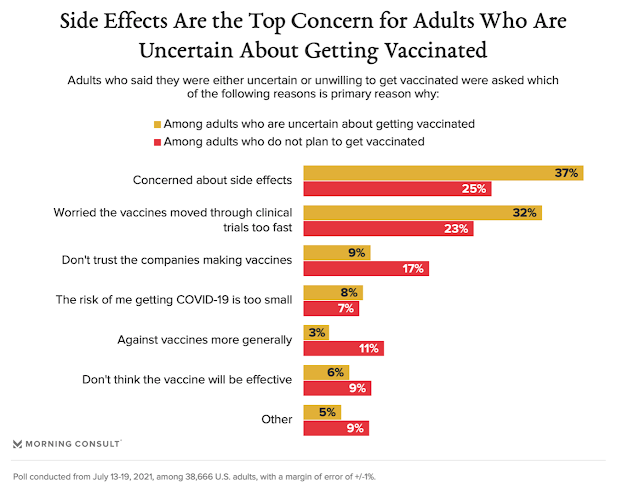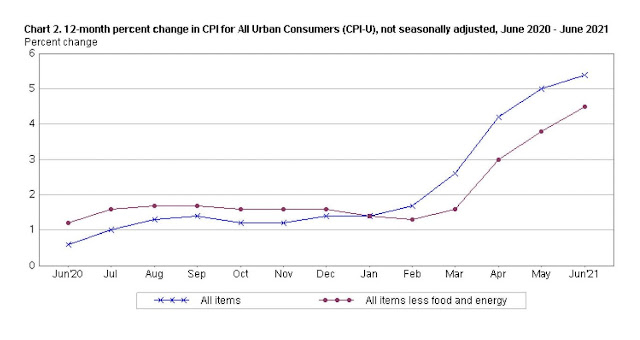The Delta variant of COVID-19 has spread like wildfire. Unsurprisingly, so has the panic behind the Delta variant. The CDC reversed its previous lifting of mask mandate recommendation and have recommended that vaccinated people living in areas of high infection rates wear masks indoors because of this new variant. Los Angeles and Washington, D.C. have already reinstated mask mandates indoors, although they are not considered "high risk" by the CDC. It doesn't surprise me that the CDC panicked both because they are risk-averse and because they have had horrible public health messaging throughout the pandemic, but I digress.
Because of the Delta variant, another policy idea is reemerging: vaccine mandates. It is not only the Left advocating for the idea. The Wall Street Journal, which tends to lean to the Right, even released a piece calling for vaccine mandates. I wrote a piece at the beginning of March entitled "We Don't Need a COVID Vaccine Mandate." I had a few reasons to say "No" to a vaccine mandate, from the "wait and see crowd" turning into people who will get vaccines, the possible backfiring in a polarized society, the constitutional arguments, the normative argument of "my body, my choice," and questioning whether COVID is severe enough to warrant such a response. Has so much changed, specifically with the nature of the Delta variant, that I would change my mind on the matter?
One of the major concerns behind the Delta variant is that it is more contagious. By how much? It is likely to be 60 percent more contagious than the Alpha variant. The Alpha variant was about 50 percent more contagious than the original strain from Wuhan, which is to say that the Delta variant is about twice as contagious as the original strain.
One response to the contagiousness of the Delta variant is wondering whether it will come as quickly as it came. The United Kingdom, which had the Delta variant sooner, is already seeing a drop in cases because the United Kingdom peaked sooner than anticipated. Former FDA Commissioner Scott Gottlieb said this past Monday that this could be indicative of what will happen in the United States.
The bigger concern should not be with cases, but with hospitalizations and deaths. I thought that was the case early on in the pandemic. After all, if an increase in cases do not result in a comparable increase in hospitalizations or deaths, then why are we using cases as a metric? Hospitalizations and deaths are better indicators of the severity of COVID. With the vaccines, that is even more so the case. The COVID vaccines have shown to be safe and effective. The jury is still out on whether the vaccine is effective against the Delta variant, although a preliminary study from the New England Journal of Medicine shows that the effectiveness of the Pfizer in the U.K. dropped slightly, from 93.7 percent to 88.0 percent (Bernal et al., 2021). The fact that 97 percent of COVID hospitalizations and 99 percent of COVID deaths in recent months in the United States are among the unvaccinated should tell you something about vaccine effectiveness.
I would say that the vaccines are clearly effective, but that is not obvious for a number of Americans. According to Morning Consult polling from earlier this month (see below), you are dealing with people who do not trust the vaccines for one reason or another, ranging from concerns about side effects to the clinical trials going too fast or distrust of vaccine companies. It was because of that hesitancy that I wrote a piece addressing those concerns and detailing why those concerns do not mitigate the fact that the risk of taking the vaccine is smaller than going unvaccinated.
The profile of a "typical unvaccinated" has a partisan divide (i.e., Republicans less likely to get vaccinated for political reasons), as well as an income divide (lower-income less likely to be vaccinated) and age divide (younger people are less likely to get vaccinated because they are less at risk, even though long-COVID is still a possibility for younger adults). While improving access would help, the Left-leaning Vox tacitly admits the bigger hurdle is getting past people's hesitancy. Even with access issues, people are not going to find ways to get past logistical issues of obtaining a vaccine if they do not want a vaccine or are unsure about getting one. If it is indeed about being unsure about the vaccines, as polling suggests, then a vaccine mandate is not going to help with that reluctance. It will only polarize what should be a scientific question further.
If the main obstacle to reaching herd immunity is not access, but hesitancy, then people should be free to make their own choices. They should also be able to observe that those who are being affected at this stage in the pandemic are the unvaccinated. More to the point, hospitalizations and deaths have not increased to a level anywhere near the peaks that have been experienced throughout this pandemic, even though the Delta variant has been in the United States since March 2021. I include a chart below of the nationwide hospitalization trends to illustrate my point. Johns Hopkins also provides state-level trends (see here).
I urge you to look at more localized data (e.g., county level, hospital level) of hospitalizations and deaths to get a better sense of the trends, but the overall trends are the following. The vaccines have been really good at preventing severe COVID and COVID-related deaths. The other takeaway is that herd immunity, which is the combination of natural immunity for those who already have COVID and those who have immunity from the vaccines, is at least high enough to keep hospitals from being overwhelmed in most areas. I say "most" because the areas struggling right now are those with lower vaccination rates. Plus, let's consider that the COVID death rate in the United States is at an extreme low, even in spite of the spike in cases.
Even so, this brings me to my final point: the idea of eliminating COVID was a fool's errand. Forget that we have only eradicated two infectious diseases to date, smallpox and rinderpest. The "Zero COVID" approach, which is the notion that the government could eradicate coronavirus from a country, was not going to work. If the Delta variant has shown us anything, it has shown how the "Zero COVID" approach has failed spectacularly. These "Zero COVID" countries took on strict lockdowns, a policy that doesn't work in slowing the spread of COVID. Not only did these countries fail to ultimately contain the spread of COVID, but they destroyed their economies and the livelihoods of millions of global citizens doing so.
Where I am going with this is that the pandemic eroded the ability for people to handle and assess risk. There is no such thing as a zero-risk option, whether that is with contracting COVID or getting vaccinated. There are only tradeoffs. To quote GAVI, which is the world's premier vaccine alliance, "Ultimately though, we will need to learn to live with this virus. Based on what we know about previous pandemics, COVID-19 should eventually become less dangerous, and coronavirus infections more predictable...the wider pandemic is unlikely to end with a single big bang...rather infections in different parts of the world may gradually fizzle to the point where we co-exist with COVID-19 in a perhaps tolerable, if imperfect, equilibrium."
Let's summarize what we have here. Vaccines are safe and effective. At least in the developed world, they are doing a good job at mitigating severe COVID and COVID-related deaths. This is another reason why getting vaccines to the rest of the world: because it is vital for the endgame of this pandemic. Even though vaccines are a good idea, the mandate is still not a good idea.
There is the political polarization, which would only be exacerbated with a mandate. The Delta variant has not been so prevalent that it has pushed hospitalizations or deaths to new highs, which is important for the goal of "flattening the curve." If anything, they have stayed significantly lower relative to the rise in cases. The fact that hospitals are not overwhelmed in most jurisdictions, in spite of cases rising, is a good sign. Plus, there are better ways to get people vaccinated, whether it is through subsidies or improved messaging to those who have yet to receive the vaccine. Those advocating a vaccine mandate are trying to force a fantasy in which there is a world without COVID. A vaccine mandate is not going to change that COVID will most probably be endemic and we as a society will have to learn to live with COVID.


